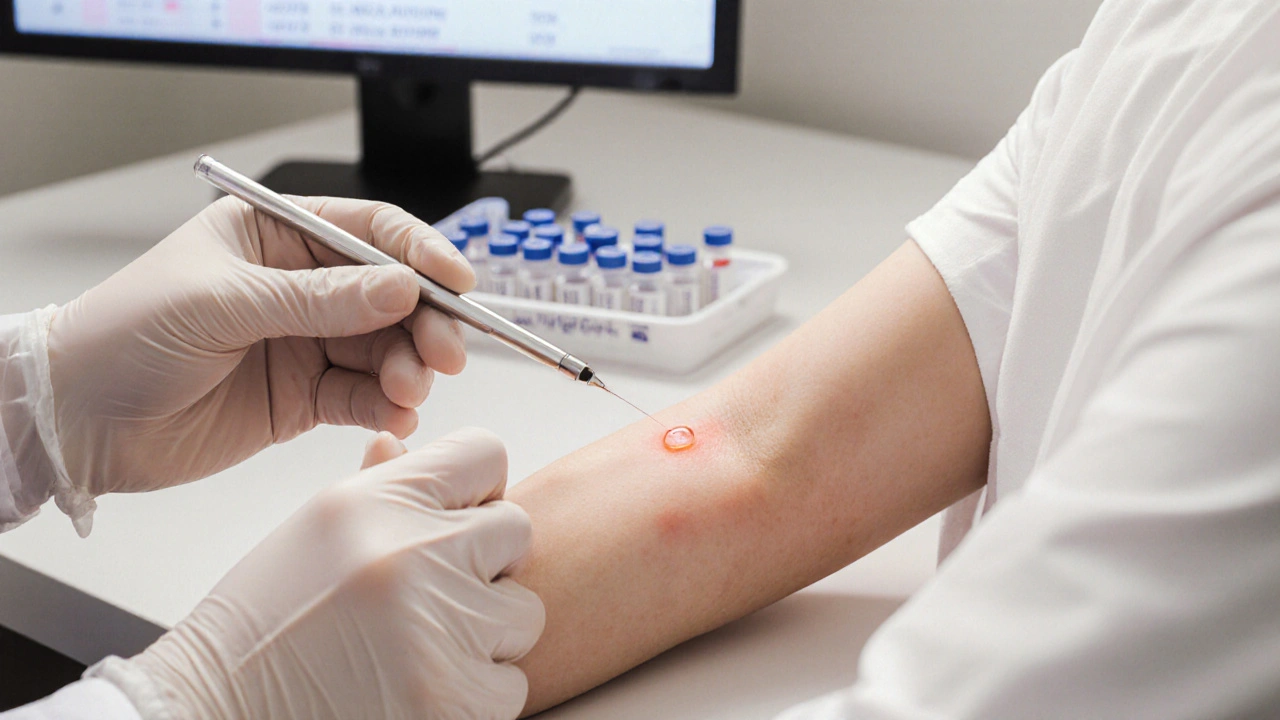Allergy Symptom Checker
Find Your Allergy Triggers
Answer a few questions to identify possible allergens based on your symptoms and environment.
Quick Takeaways
- Allergic disorders happen when IgE antibodies mistakenly flag harmless substances as threats.
- Mast cells release histamine, causing the classic itching, sneezing, and swelling.
- TypeI hypersensitivity is the most common allergy mechanism, but other types exist.
- Diagnosis relies on skin tests, blood tests for specific IgE, and a detailed symptom history.
- Management ranges from avoidance and antihistamines to long‑term immunotherapy.
What Exactly Are allergic disorders?
When you hear allergy you probably picture sneezing during pollen season or a rash after eating peanuts. In science terms, an allergic disorder is an over‑reaction of the immune system to a normally harmless substance called an allergen. The body treats the allergen like a dangerous invader, launching a cascade that ends in the symptoms we all know and hate.
How the Immune System Mistakes Friendly Substances for Enemies
The key players in the allergic response are IgE antibodies and mast cells. Here’s the step‑by‑step drama that usually unfolds:
- Sensitization: The first time you encounter an allergen, a special class of helper T‑cells called Th2 cells convince B‑cells to create IgE that match the allergen’s shape.
- IgE coating: Those IgE molecules hitch a ride on the surface of mast cells and basophils, lining them up like tiny sensors.
- Re‑exposure: When the same allergen shows up again, it links two nearby IgE antibodies, cross‑linking the mast cell’s receptors.
- Degranulation: The mast cell gets the signal to explode, dumping histamine, leukotrienes, and other cytokines into surrounding tissue.
- Symptoms appear: Histamine widens blood vessels, irritates nerves, and makes mucus membranes swell-hence itching, redness, sneezing, or wheezing.
This cascade is what doctors label a typeI hypersensitivity reaction. It’s fast, often within minutes, and can range from a mild rash to a life‑threatening anaphylactic shock.

Beyond TypeI: Other Forms of Hypersensitivity
Allergies don’t all follow the IgE‑mast‑cell script. The classic Gell‑Coombs classification lists four types:
| Type | Key Immune Component | Typical Example | Onset Speed |
|---|---|---|---|
| I | IgE‑mediated mast cell degranulation | Hay fever, food allergy | Minutes |
| II | IgG/IgM antibodies + complement | Autoimmune hemolytic anemia | Hours‑days |
| III | Immune complex deposition | Serum sickness, rheumatoid arthritis | Hours‑days |
| IV | Cell‑mediated (T‑cells) | Contact dermatitis, TB skin test | Days |
While typeI dominates everyday conversations about allergies, acknowledging the other types helps clinicians rule out mimicking conditions.
Common Allergic Disorders and What Triggers Them
Here are the most frequently seen allergic conditions, grouped by the organ they affect:
- Respiratory: Allergic rhinitis (pollen, dust mites), allergic asthma (pet dander, mold).
- Dermatologic: Atopic dermatitis (food allergens, irritants), urticaria (insect venom, medications).
- Gastrointestinal: Food allergy (peanuts, shellfish) leading to hives, vomiting, or anaphylaxis.
- Systemic: Anaphylaxis - a rapid, whole‑body reaction that can be triggered by any of the above.
Each disorder shares the same underlying IgE‑driven mechanism, but the location of mast cells and the local cytokine environment shape the specific symptoms.
Seeing the Signs: How Doctors Diagnose Allergies
Diagnosis is a mix of patient history, physical exam, and targeted testing. The most reliable tools are:
- Skin Prick Test (SPT): A tiny drop of allergen is pricked into the skin. A wheal bigger than 3mm after 15minutes signals sensitization.
- Specific IgE Blood Test: Laboratory assays (e.g., ImmunoCAP) quantify IgE levels for particular allergens. Useful when skin testing is unsafe.
- Oral Food Challenge: The gold standard for food allergy, performed under medical supervision to confirm true reactivity.
- Clinical Correlation: Labs alone don’t prove disease; the doctor matches test results with real‑world symptom patterns.
False‑positives happen, especially with low‑level IgE. That’s why doctors stress the importance of a clear history-when the symptom started, what you were doing, and how severe it was.

Managing Allergic Reactions: From Quick Relief to Long‑Term Control
Most people manage day‑to‑day exposure with two strategies: avoidance and medication.
Avoidance Tips
- Check pollen forecasts and keep windows closed during high‑count days.
- Use dust‑mite‑proof covers on pillows and mattresses; wash bedding in hot water weekly.
- Read food labels carefully; look for hidden sources like “may contain” statements.
- For pet allergies, keep animals out of bedrooms and use HEPA air purifiers.
Medication Toolbox
- Antihistamines (e.g., cetirizine, loratadine) block histamine receptors, easing itching and sneezing.
- Leukotriene receptor antagonists (montelukast) help with asthma and nasal congestion.
- Corticosteroid nasal sprays reduce inflammation for chronic rhinitis.
- For severe reactions, carry an epinephrine auto‑injector. Use it promptly and call emergency services.
Desensitization: Allergen Immunotherapy
When avoidance isn’t realistic-think pollen or bee stings-doctors may offer immunotherapy. Over 3‑5 years, gradually increasing doses of the allergen retrain the immune system, shifting the response from IgE‑driven to a safer IgG‑dominant profile. Studies in 2023 showed a 40% reduction in medication use for treated patients.
What the Future Holds: New Frontiers in Allergy Research
Science is moving fast. A few promising avenues include:
- Biologic drugs: Monoclonal antibodies like omalizumab bind free IgE, lowering the pool that can trigger mast cells. Recent trials report 60% fewer asthma exacerbations.
- CRISPR‑based gene editing: Early‑stage studies aim to knock out the FcεRI receptor on mast cells, potentially eliminating IgE‑mediated reactions entirely.
- Microbiome modulation: Gut bacteria influence Th2 cell development. Probiotic formulations are being tested to prevent childhood allergies.
- Nanoparticle vaccines: Tiny carriers deliver allergen peptides to induce tolerance without causing a full‑blown reaction.
While many of these are still in clinical trials, they signal a shift from merely controlling symptoms to actually re‑programming the immune response.
Quick Checklist for Anyone Suspecting an Allergy
- Track when and where symptoms appear.
- Note any possible triggers (food, environment, medications).
- Schedule a visit with an allergist for skin or blood testing.
- Start an avoidance plan based on test results.
- Keep rescue medication (antihistamine or epinephrine) on hand if you have a history of severe reactions.
Frequently Asked Questions
Why do some people develop allergies while others don’t?
Genetics set the stage - families with a history of atopy (asthma, eczema, hay fever) are more prone. Environmental factors, like early‑life exposure to diverse microbes, also shape the immune system’s tolerance mechanisms.
Can an adult outgrow a food allergy?
Yes, especially with allergies to milk, egg, soy, and wheat. About 20‑30% of children outgrow these by age5. Peanut and tree‑nut allergies are more persistent, but oral immunotherapy can increase tolerance.
Is a negative skin prick test enough to rule out an allergy?
Not always. Some allergens (like certain foods) don’t produce a strong skin response, so a specific IgE blood test or supervised oral challenge may be needed.
How fast does an epinephrine auto‑injector work?
Epinephrine starts acting within minutes, narrowing swollen airways, raising blood pressure, and stopping hives. Prompt use is critical; delay can increase the risk of fatal anaphylaxis.
Are natural remedies like honey or herbal supplements effective for allergies?
Scientific evidence is limited. Some honey may expose you to low pollen levels, but results are inconsistent. Always discuss supplements with a doctor to avoid interactions.
